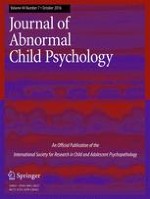26-12-2015
Developmental Trajectories of Boys’ Driven Exercise and Fasting During the Middle School Years
Gepubliceerd in: Research on Child and Adolescent Psychopathology | Uitgave 7/2016
Log in om toegang te krijgenAbstract
Boys appear to engage in eating disorder behavior, particularly nonpurging compensatory behaviors such as driven exercise and fasting, at higher rates than previously thought. Little is known about the development of these behaviors in adolescent boys. In a sample of 631 non-binge eating and non-purging boys studied once in 5th grade and 6 times over the 3 years of middle school (grades 6 through 8), we found that (a) for some youth, driven exercise and fasting were present from grade 6; (b) different boys progressed along different trajectories of engagement in driven exercise and fasting, with some boys engaging in no driven exercise or fasting (65.8 % and 83.5 %, respectively), some boys engaging in driven exercise and fasting throughout middle school (25.2 % and 16.5 %, respectively), and other boys discontinuing engagement in driven exercise (9 %); (c) 5th grade depression, eating expectancies, and thinness expectancies predicted subsequent trajectory group membership; and (d) boys engaging in driven exercise and fasting in 8th grade remained distressed. Boys’ engagement in driven exercise and fasting behavior merits the attention of researchers and clinicians.
